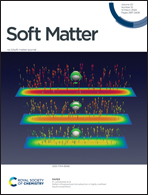Self-assembly of rigid amphiphilic graft cyclic-brush copolymers to nanochannels using dissipative particle dynamics simulation†
Abstract
The synthesis of specific artificial nanochannels remains a formidable challenge in the field of nanomaterials and synthetic chemistry. In particular, the preparation of artificial nanochannels using amphiphilic graft cyclic-brush copolymers (AGCCs) as monomers has garnered substantial attention. Nevertheless, because of the constrained time and length scales inherent in traditional molecular dynamics simulations, a comprehensive theoretical understanding of the morphological regulation mechanism governing the self-assembly of AGCCs into nanochannels remains elusive. In this study, we employed the dissipative particle dynamics (DPD) method to explore the self-assembly mechanism considering factors such as the DPD interaction parameters, concentrations, and sizes of AGCCs. By calculating the phase diagrams, we predicted the emergence of four distinct nanochannel types: short independent, long independent, parallel, and disordered channels. Importantly, the formation of these nanochannels is highly contingent on specific environmental conditions. Furthermore, we extensively discussed self-assembly processes that lead to different types of nanochannels. The self-assembly of AGCCs is revealed as a multistep process primarily influenced by the interaction parameters. However, while the monomer size and concentration do not introduce novel self-assembly morphologies, they do influence the final aggregation state. The elucidation of the self-assembly mechanism presented in this study deepens our understanding of AGCC nanochannel formation. Consequently, this is a valuable guide for the preparation of copolymer materials with specific functionalities, offering insights into targeted copolymer material design.



 Please wait while we load your content...
Please wait while we load your content...